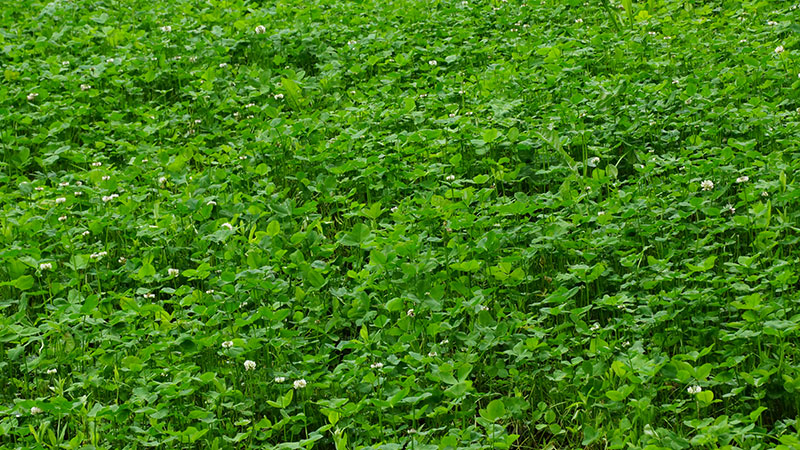5 Steps to creating the Perfect Clover Plot
In 2013 I decided to convert a 2-acre field adjacent to my pole barn into a food plot. The soil was just OK and I knew it would need help. Three years later this plot is the best ladino clover plot I’ve ever planted. It is entirely weed free and heavily utilized by deer. In this article I share my 5 steps to creating a plot like this so you can have one just like it on your property.
These steps seem simple, but there is more to it than meets the eye. Pay particular attention to the dates as they are not random. I am deliberately starting the field prep at a time which will maximize weed control and continuing the “cleansing” process throughout the summer. Ultimately, I am planting after most of the weeds have cycled out and killed. The objective is to plant into a clean field where the only seeds sown are the desired ones.

Please note: the dates below are for plots north of the Mason Dixon Line. I would plant September if you are to the south of that line.
Step 1 - Soil Test (May)
This is the most important step and one that a lot of hunter’s overlook. I took 3 soil samples from this field in May and all three had slightly different results. Soil tests are easy and free and they will save you a lot of money in the long run.
Step 2 - Apply Herbicide (June)
While the field was actively growing in early June, and before my soil tests were back, I did a tank mix of Glyphosate at 3oz per gallon, mixed with 2-4D Amine at 1oz per gallon. This is definitely a hot mix and I made sure I applied evenly across the growing vegetation. One month later everything was yellow and dead.
Step 3 - Tilling (July - post rain)
Five days after a good soaking rain I disked the soil until it was soft and fluffy. I have sandy loam soil so this was easier than if it was clay. You may need to plow first if the ground is really dry and hard.
Step 4 - Fertilize and Lime (July)
With my soil test results in hand, I followed the instructions provided by the soil service with one exception -Â I increased the lime recommendation by 50%. I broadcasted the amendments with a cyclone spreader right on top of the tilled soil. Immediately after applying the lime and fertilizer, I disked once more. This accomplished two things. First, the second disking mixed the lime and fertilizer into the top 4” of the soil. The other thing it did was to wipe out the next generation of growing weeds. This often occurs with tilling since some legacy weed seeds lay dormant, deep in the soil, then become activated through tilling.
Step 5 - Final Tilling and Planting (August)
The last week of August I planted my perennial plot (ladino clover) along with a companion (nurse) plot of Daikon Radishes. I went heavier than the recommended rate for ladino clover and I went light on the radish seeding rate.
Results. Don’t expect to see a lush clover plot after planting. Clover takes a while to build a root structure and establish itself. The following spring, I visited the plot and was amazed at what it had become. Now the maintenance begins.
5 Steps to maintaining the perfect clover plot

The picture above was taken June 13, 2016, 3 years after I established this plot. Results like this take work.
Apply 2,4DB herbicide (May)
This broadleaf herbicide can be applied directly over clover and alfalfa with no harmful effects. Apply 2,4DB at a rate of 3oz per gallon of water and spray early morning or late afternoon when there is no forecasted rain for 24 hours. You will notice some weeds twisting and dying right away, others may take up to a month before they succumb. Have patience, it works well. Important, 2,4DB and 2,4D are two different products. You can spray 2,4DB on top of clover. 2,4D will kill everything including the clover. Pay attention!
Apply Clethodim herbicide (May)
This grass herbicide takes a good month to fully work its magic but it will work if applied correctly. Apply a combination of Clethodim at a rate of .5oz per gallon of water and Crop Oil at .5oz per gallon of water, then spray early morning of late afternoon when there is no forecasted rain for 24 hours. The grass will wither, turn yellow and eventually disappear.
Mow Your Plot (Late Spring until Late Summer)
A good rule of thumb is to clip at half the height of your clover but no shorter than 5 inches. Don’t clip during a drought. Mowing will stimulate the clover. It may seem painful to clip that lush clover field but within a week it will be back and better than before.
Frost Seed (Late Winter or Early Spring)
Some areas of your plot may be weaker than others so I always have a pound or two of the same clover variety available to spread over any bare spots. The effects won’t be seen right away but over time you will have a remarkable plot.
Admitting Defeat
I have three clover plots. Two of them are spectacular. One of them sucks because I failed to follow the steps above. So this year I am burning it down and starting over. If you are continually fighting weeds and grass, there comes a time when you simply need to throw in the towel and start fresh. The field above is in year 3, I have another field in year 6 that looks just as good. But they won’t last forever.



